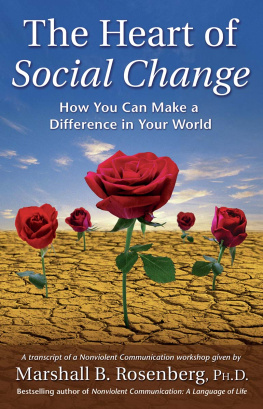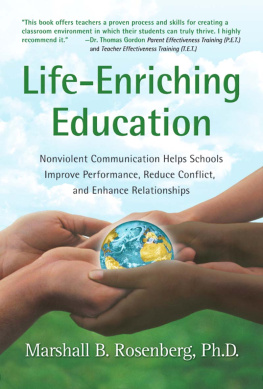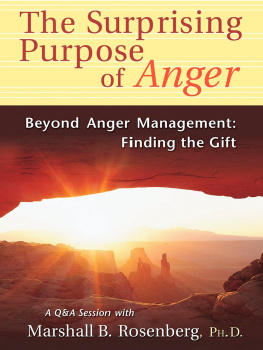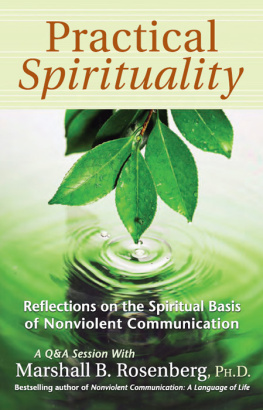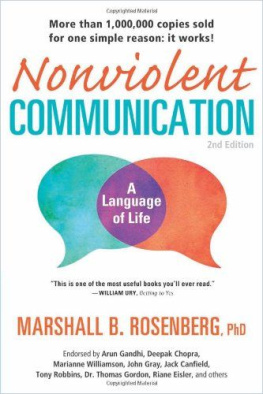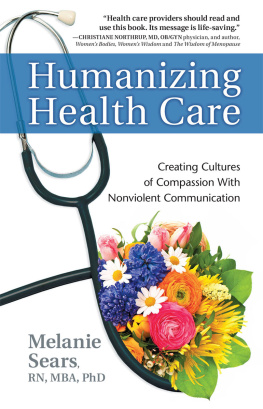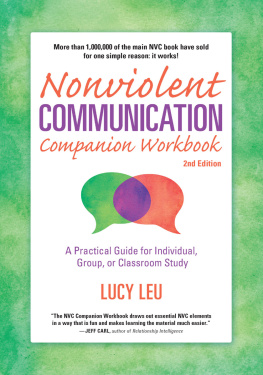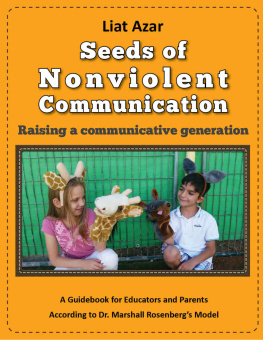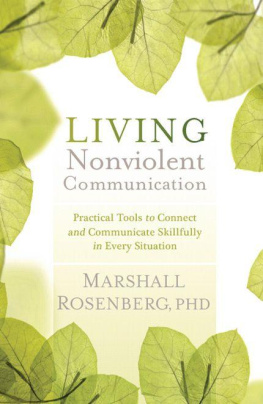Marshall B. Rosenberg - The Heart of Social Change: How to Make a Difference in Your World
Here you can read online Marshall B. Rosenberg - The Heart of Social Change: How to Make a Difference in Your World full text of the book (entire story) in english for free. Download pdf and epub, get meaning, cover and reviews about this ebook. year: 2004, publisher: PuddleDancer Press, genre: Religion. Description of the work, (preface) as well as reviews are available. Best literature library LitArk.com created for fans of good reading and offers a wide selection of genres:
Romance novel
Science fiction
Adventure
Detective
Science
History
Home and family
Prose
Art
Politics
Computer
Non-fiction
Religion
Business
Children
Humor
Choose a favorite category and find really read worthwhile books. Enjoy immersion in the world of imagination, feel the emotions of the characters or learn something new for yourself, make an fascinating discovery.
- Book:The Heart of Social Change: How to Make a Difference in Your World
- Author:
- Publisher:PuddleDancer Press
- Genre:
- Year:2004
- Rating:5 / 5
- Favourites:Add to favourites
- Your mark:
- 100
- 1
- 2
- 3
- 4
- 5
The Heart of Social Change: How to Make a Difference in Your World: summary, description and annotation
We offer to read an annotation, description, summary or preface (depends on what the author of the book "The Heart of Social Change: How to Make a Difference in Your World" wrote himself). If you haven't found the necessary information about the book — write in the comments, we will try to find it.
The tenets of Nonviolent Communication are applied to a variety of settings, including the classroom and the home, in these booklets on how to resolve conflict peacefully. Illustrative exercises, sample stories, and role-playing activities offer the opportunity for self-evaluation, discovery, and application.
This insightful perspective on effective social change is illustrated with how-to examples.
Marshall B. Rosenberg: author's other books
Who wrote The Heart of Social Change: How to Make a Difference in Your World? Find out the surname, the name of the author of the book and a list of all author's works by series.
The Heart of Social Change: How to Make a Difference in Your World — read online for free the complete book (whole text) full work
Below is the text of the book, divided by pages. System saving the place of the last page read, allows you to conveniently read the book "The Heart of Social Change: How to Make a Difference in Your World" online for free, without having to search again every time where you left off. Put a bookmark, and you can go to the page where you finished reading at any time.
Font size:
Interval:
Bookmark:
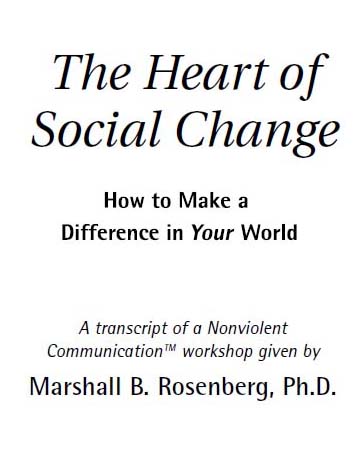

P.O. Box 231129, Encinitas, CA 92023-1129
For additional information:
Center for Nonviolent Communication, 2428 Foothill Blvd., Suite E, La Crescenta, CA 91214
Tel: 818-957-9393 Fax: 818-957-1424 E-mail:
ISBN: 1-892005-10-7
Copyright 2005 PuddleDancer Press
Published by arrangement with the Center for Nonviolent Communication. All rights reserved.
No part of this booklet may be reproduced by any means, nor may it be stored, transmitted or otherwise copied without permission of the publisher.

T his booklet contains excerpts from a workshop given by Marshall Rosenberg in San Diego in May, 2000, and serves as an introduction to his wisdom on effective social change. In narrative commentary and role-play, he returns our focus to basic questions: What is at the root of any social problem? What needs am I meeting in getting involved? What do we need to affect change?
From the manner in which we communicate, to the intention we bring to every interaction and the organization structures we support, social change begins with me. Marshall shows how Nonviolent Communication can help you create an internal culture of peace that will help you effect lasting social change. In the role plays participants are identified as UF (unidentified female participant), UM (unidentified male participant), and MBR (Marshall B. Rosenberg). All other words are Marshalls. We pick up the conversation with a question from one of the participants in the workshop.
UM: Im just curious, what can we do to change the source of social problems instead of dealing with the symptoms of all the problems, to get to the root of where all this is coming from? What can we do to change what happened eight thousand years ago, or maybe duplicate it in a compassionate way so that we can change it in the next eight thousand?
MBR: First, I can tell you a strategy that Im trying to follow myselfthe best that Ive found at this point. Its this: change the paradigm within myself, to liberate myself from the way I was programmed and to be in harmony with how I choose to live, with how I reflect the story that resonates the most in my heart. In other words, I strive to create that chosen world within. Peace begins with me.
Next, I really like the paradigm that Ive chosen. Ive found out that its nothing new. I was just told in British Columbia by some indigenous people that I was working with up there that they liked what I presented. They said, You know, Marshall, this is just what our elders taught us, and Ive been told by Palestinians I work with that what Ive come up with as a new paradigm for myself is just Islam. What Ive come up with works for me and also seems to be something that other people have chosen for their own paradigm. So lets do our best to share the new paradigm with others. Thats one way to create social change. Share what works for us, what makes our life richer without blasting the old paradigm, without calling them a bunch of bigots tell what we like about our story, and how its enriched our life.
Then we can get clear what social structures would look like. What would gangs (see The Concept of Gangs and Social Structures, page ) look like that function in harmony with the paradigm of our choosing? And how can we develop our skills to radically transform existing structures into ones that are in harmony with our paradigm?
Then I ask: What education is necessary for people to have our paradigm so that they can create other structures that resemble our paradigm? Im trying to work in all four of these areas together.
That last oneeducationis one I put a lot of energy into. I want to get the next generation of people around the world educated in a radically different paradigm, and with skills for creating structures that support the new paradigm. So, for example, we not only teach the kids in the school, we also set up Nonviolent Communication training with their parents, teachers, and administrators. And equally important is that the school is a reflection of the kind of government that we would like to see. It shows leaders as servants. Teachers are servants of the students; the administrators are servants of the teachers. Rewards and punishment are not used. The relationships among the student body are created as interdependent relationships, not as competitive ones. Tests are not given to determine grades. Tests are given to determine whether the teacher has done his or her job. Theyre not tests of the students; theyre tests of the learning process. This is what my book Life-Enriching Education is about.
Life-Enriching is the key concept in my paradigm: every action comes out of an image of seeing how human needs would be met by the action. Thats the vision that mobilizes everything. A life-enriching organization is one in which all work in the organization, everything that every worker does, comes out of seeing how its going to support life in the form of meeting needsneeds of the physical planet, trees, lakes, or human beings or animalsand its clear how life will be served through meeting of needs. And thats the vision that inspires the actions, purely. In a life-enriching structure, nobody works for money. Money plays the same role as food for a mother who is breastfeeding her infant. She doesnt receive food as payment. The food is nurturance so she has the energy to serve life. It all boils down to human needs, which is why Nonviolent Communication is so rooted in the consciousness of needs. Everything we do is in the service of needs and the pleasure that is felt when needs are fulfilled, especially spiritual needs. Those are the most fun needs to fulfill.
To me, the bees and the flowers are part of a life-enriching organization. Look at how they both meet each others needs. They dont do it through any guilt, duty, or obligation, but naturally, in a natural system. The bee gets its nectar from the flower and it pollinates the flower.
It is hard to separate meeting human needs from the needs of the environment: They are one and the same. Meeting the needs of all the phenomena on the planet. Seeing the oneness of it all. Seeing the beauty in that whole scheme, that whole interdependent scheme of life. Life-enriching structuresthe kind of structures that I would like to see us creating and participating inare structures whose vision is to serve life. And how do we know if an organization whether its a family, or work team, or governmentis a life-serving organization? We find out by asking: Is its mission to meet the needs and enrich the lives of people withinand affected bythe organization?
And what do people need? Money is not a need. Its a strategy that sometimes might meet a need. Fame is not a need. Status is not a need. These are things that domination structures use to mislead peopletake a real need and misrepresent it, and get people to think that these false things are the needs. So, a life-enriching organization, in fact, serves life, serves needs. Next, all work done within a life-enriching structure is motivated by the mission. Not by money, not by salary, not by position, not by status. Every bit of work that a person does is coming from this joy of meeting that mission. And life-enriching organizations give the workers within them the nurturing they need to live that mission. Now, heres where money comes into play. They might get a salary for some food for their family and themselves, but thats not why theyre doing the work. Theyre motivated to do the work purely by the life-serving mission. But the most important part of an organization in this respect isnt the money. A life-enriching organization must be set up to be very good at getting genuine gratitude to every worker. Thats the fuel necessary to keep people working in a life-enriching organization. Sincere gratitude. When you do so people can see how their efforts are instrumental in the life-serving mission.
Next pageFont size:
Interval:
Bookmark:
Similar books «The Heart of Social Change: How to Make a Difference in Your World»
Look at similar books to The Heart of Social Change: How to Make a Difference in Your World. We have selected literature similar in name and meaning in the hope of providing readers with more options to find new, interesting, not yet read works.
Discussion, reviews of the book The Heart of Social Change: How to Make a Difference in Your World and just readers' own opinions. Leave your comments, write what you think about the work, its meaning or the main characters. Specify what exactly you liked and what you didn't like, and why you think so.

